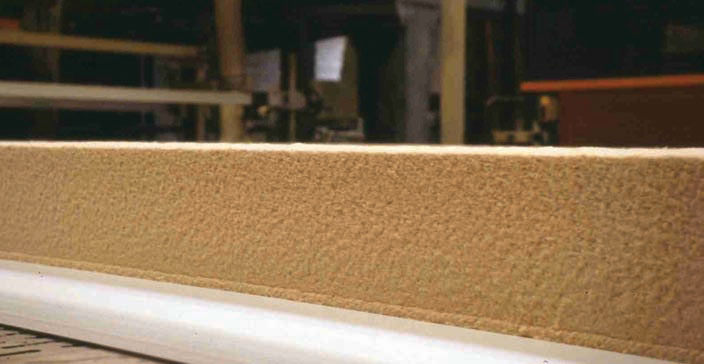Surface Density gives MDF Strength
14 July 2017MDF may at first glance look uniform; but the hot-pressing process imparts layers of differing density. Dr. Mark Irle explains why this is so advantageous.
MDF has the reputation of being an homogenous panel with good mechanical properties, very smooth surfaces and excellent machining characteristics.
These enviable qualities are due, in part, to the fact that MDF is made of small elements, termed fibres within the industry. An equally important factor behind the impressive performance of MDF is the way these fibres are compressed into a panel.
The pieces of wood in an MDF range in size from cell fragments to fibre bundles, some of which will be large enough to resemble wood and are called shives; but even these are still much smaller than the particles used to make particleboard. The homogenous nature of the furnish is quite apparent in Figure 1, which shows an MDF mattress after prepressing and trimming, but before hot-pressing. The mattress really does resemble something that you might sleep on.
Wood fibres have aspect ratios of around 100 – in other words they are 100 times longer than they are thick. This factor combined with the very uniform adhesive distribution explains part of the story of why MDF is mechanically stronger than particleboard.
Another very important factor, which also explains the high performance of the surface layers, is the density profile of MDF, ie, the variation in density through the thickness of the panel.
Although an MDF mattress immediately before hot-pressing is an homogenous single layer mattress, it will have pseudo layers after hot-pressing. Close examination of a panel edge, like that in Figure 2, reveals darker surface layers.
These are caused by the higher density of the surface layers. The mattress surfaces warm very quickly on contact with the hot platens of the press and so they tend to compress much more readily than the cool inner portions of the mattress. In parallel, the adhesive begins to polymerise and fixes the surfaces into their compressed state.
A typical MDF has surface densities of around 1000kg/m3 (62.4lb/ft3), which project between 1 to 2mm into the thickness of the panel. The density of the rest of the panel is much lower, in the order of 600 – 700kg/m3. The density profile should resemble a flat bottomed U shape.
This density profile gives good bending properties relative to weight because in bending the stresses are highest in the surfaces. High density surfaces equate to high resistance to deformation and good strength. Since the surfaces are dense, they are also scratch resistant and have a low permeability to liquids and this can significantly reduce finishing costs when paints, lacquers and stains are applied to the faces.
The advent of continuous presses has enabled manufacturers to finely tune their density profiles to meet specific customer requirements and thereby maintain the reputation of MDF.

